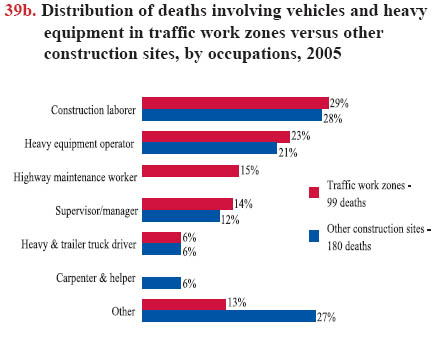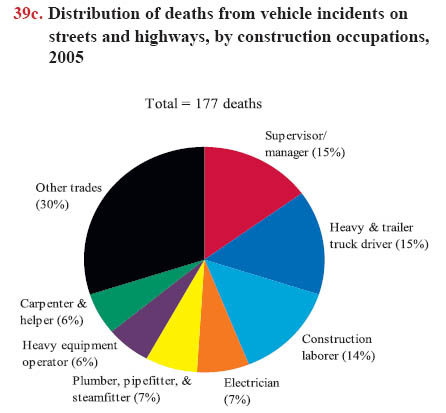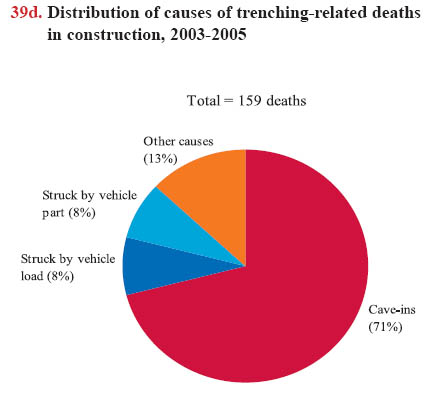Summary Statement
A broad collection of tables and charts covering health and safety in the U.S. construction industry, as well as considerable economic and training data.
2007
Section 39: Deaths Involving Vehicles and Heavy Equipment in Construction
Vehicles and mobile heavy equipment were involved in 469 deaths (37.7%) out of a total of 1,243 construction deaths in 2005. However, vehicles were not always listed as “cause of death” in these fatalities. Causes of deaths varied: "struck by" a vehicle and highway collisions were obviously caused by vehicles and were categorized as such. Other deaths involving vehicles were identified in the U.S. Bureau of Labor Statistics’ (BLS) categories "caught in/between" and "falls," such as a worker being caught between parts of a dump truck or falling from a piece of mobile heavy equipment.
Of the 469 vehicle- and mobile heavy equipment-related deaths in 2005, 279 occurred on construction sites (59%), which included traffic work zones. Mobile heavy equipment was involved in 42% of these construction site deaths, trucks in 23%, road vehicles in 14%, forklifts in 11%, and aerial lifts in 8%. During that same period, 177 deaths occurred on streets and highways, accounting for 38% of the total vehicle-related construction deaths. These included 162 deaths of drivers and passengers, plus 15 deaths of workers who were struck by vehicles on highways. Of the vehicle occupant deaths, 7% involved mobile heavy equipment (such as bulldozers and backhoes), 34% heavy trucks, and 56% other road vehicles (such as cars and pickup trucks). In addition, there were 13 deaths of construction workers doing mostly vehicle maintenance/repair or unloading at industrial yards, not at construction sites.Ninety-nine of the 279 construction site deaths, or 35%, that involved vehicles and heavy equipment happened in traffic work zones for highway, street, and bridge construction (NAICS 2373). These traffic work zones had twice the percentage of deaths among workers on foot compared to other construction sites. In more than 71% of the traffic zone deaths, the workers were struck by vehicles working in the zone or passing vehicles that entered the work zone. At other construction sites, 39% struck by vehicles, 34% of the on-foot workers killed were struck by vehicle loads. By contrast, the traffic work zones had a much lower percentage of non-collision deaths (17%) compared to other construction sites (33%; chart 39a). The incidents tied to these non-collision deaths included vehicle rollovers, caught in/between incidents, and vehicle operators on foot struck by their own vehicle. Falls of non-operators from vehicles accounted for one-half of the remaining vehicle-related deaths at other construction sites.
Among deaths from vehicular incidents on streets and highways, just under half (49%) were due to collisions with other vehicles. Of non-collision deaths, 18% were due to vehicles striking stationary objects (mostly trees), and 16% were due to rollovers.
The occupations of the workers in vehicle-related deaths are shown in charts 39b and 39c. At traffic work zones and other construction sites, construction laborers and heavy equipment operators accounted for half the deaths (charts 39b). For street and highway incidents, construction supervisors/managers, heavy and trailer truck drivers, and construction laborers each accounted for about 15% of deaths (chart 39c).
Dump trucks were involved in 44 vehicle-related deaths (9% of the total 469 deaths) in 2005. A study identified 525 dump truck-related deaths in 1992-2002, or about 50 per year.1 According to the study, major causes of death included 220 deaths from being struck by a dump truck (42%), 158 deaths from highway incidents (30%), and 47 deaths from being caught in/between dump truck equipment (9%). Worker locations and activities at the time of death included worker on foot near a dump truck (42%), dump truck operator in or around the truck (39%), and worker maintaining a dump truck (10%). Half of the 220 struck-by deaths happened to on-foot workers who were struck by dump trucks backing up. About 20 deaths happened to on-foot operators who were run over by their own dump trucks. Of the 204 dump truck operators killed, 122 (60%) were involved in highway incidents: collisions with trains accounted for 17% of these deaths. At least 30 (25%) of the operators killed on the highway did not have their seat belts fastened. The 28 workers killed (53%) while maintaining or repairing dump trucks were caught between the dump truck frame and a falling dump body.
Mobile heavy equipment also played a role in trenchrelated deaths (chart 39d). Of the 159 deaths occurring from 2003-2005, being struck by vehicle loads or vehicle parts, especially excavator buckets, each accounted for 12 deaths (8%). By far, cave-ins caused the most trenching-related deaths – 113 deaths (71%). In 38 of the 113 deaths (34%), the Census of Fatal Occupational Injuries indicated there was either no shoring, or support for the trench walls was inadequate. For 64% of deaths, there was no mention of support. Construction laborers were involved in 65 of the trenching-related deaths (41%).




Download MS PowerPoint versions of Charts
1. Michael McCann and Mei-Tai Cheng. 2006. Dump truck related deaths in construction, 1992-2002. Poster presentation at the NORA Symposium, Washington, D.C., April 18-19, 2006.
Note:
Chart 39a - "Other" includes 24 deaths involving worker falls from vehicles.
Source:
Charts 39a-39c - U.S. Bureau of Labor Statistics, 2005 Census of Fatal Occupational Injuries. Calculations by Michael McCann, CPWR.
Chart 39d - U.S. Bureau of Labor Statistics, 2003-2005 Census of Fatal Occupational Injuries. Calculations by Michael McCann, CPWR.
Back to Table of Contents


